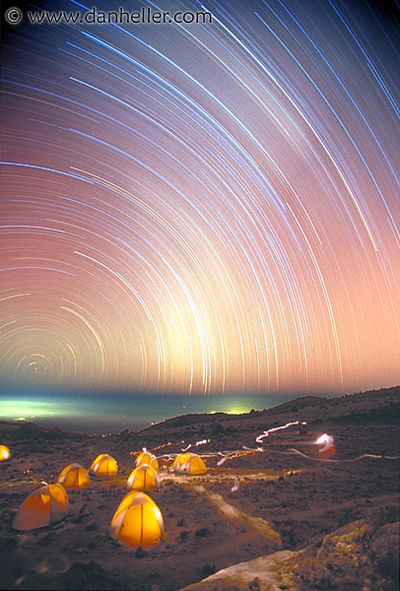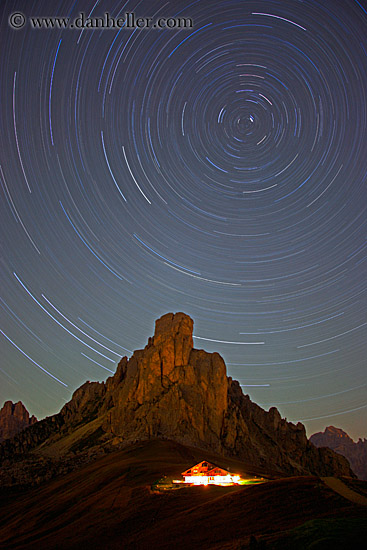أثر نجم
أثر نجم هو الخط المتواصل على صورة فوتوغرافية للسماء أثناء ظلام الليل ويحصل هذا الخط عادة من تأثير ضوء النجم فترة تعرض الفلم له بآلة تصوير ثابتة أو متحركة باتجاه مختلف عن اتجاه الحركة الظاهرية للنجم السماوى.

صورة آثار نجوم مأخوذة على مدى 3.5 ساعات في ليلة غير مقمرة، على ارتفاع 4,800 متر فوق سطح البحر على جبل كيليمانجارو، تنزانيا.
تفاصيل تقنية: Canon EOS 1v Body, EF 17-35mm f2.8 lens (@17mm/f2.8), Tiffen FL-D filter, Velvia film (rated at 40ASA), 3.5 hour time-release exposure. This shot is interesting for a variety of reasons. First, the lighting of the tents was very lucky. I hadn't intended to get them lit at all, but as people got up during the night to go to the latrine, their flashlights lit the interiors of the tents as they moved around. (Altitude causes frequent visits to the latrine, especially at night.) Second, because the night had no moon, I was concerned there wouldn't be enough light on the ground to give the scene some context. But, as it turns out, the ground was lit entirely by starlight. That seems amazing, especially because stars are normally not bright enough to do that. إلا أنه على ارتفاع 16,000 قدم، يكون الهواء رقيقاً وليس هناك تلوث ضوئي حول المكان، لدرجة أن درب التبانة Milky Way تكون مثل حزمة ضوئية هائلة عبر السماء. You can sort of make it out by a cone-shaped glow in the middle of the image from the top down to the horizon. Another other lucky factor was that the night temperature drops below feezing at that altitude. Frost or other elements could have ruined the picture simply by building up on the lens, the camera's battery dying, or by the camera simply not functioning at all. Yet, nothing went wrong.—Fun things to note The green hues on the horizon is the cloud cover at 10,000 feet being lit by the lights from the towns below. They use mostly fluorescent lights to save energy, and as you know, those tend to glow green on film. The reddish color just above the horizon fading to blue higher up is caused by the red dust kicked up from the ground below. Tanzania didn't have a lot of rain this season, and the last wet season was also particularly dry. As a result, the dryness caused a lot of the red dirt to fly everywhere. وأخيراً، النجم فوق الأفق تماماً هو القطب السماوي الجنوبي southern celestial pole. ليس هناك مناظر لنجم القطب الشمالي Polaris ("نجم الشمال") في نصف الكرة الجنوبي، لكن هذا النجم هو أقرب ما يمكن الحصول عليه. (هناك قوس صغير.) الصورة قريبة من الأفق لأن كيليمانجارو يقع على بعد ثلاث درجات جنوب خط الإستواء.[1]
تفاصيل تقنية: Canon EOS 1v Body, EF 17-35mm f2.8 lens (@17mm/f2.8), Tiffen FL-D filter, Velvia film (rated at 40ASA), 3.5 hour time-release exposure. This shot is interesting for a variety of reasons. First, the lighting of the tents was very lucky. I hadn't intended to get them lit at all, but as people got up during the night to go to the latrine, their flashlights lit the interiors of the tents as they moved around. (Altitude causes frequent visits to the latrine, especially at night.) Second, because the night had no moon, I was concerned there wouldn't be enough light on the ground to give the scene some context. But, as it turns out, the ground was lit entirely by starlight. That seems amazing, especially because stars are normally not bright enough to do that. إلا أنه على ارتفاع 16,000 قدم، يكون الهواء رقيقاً وليس هناك تلوث ضوئي حول المكان، لدرجة أن درب التبانة Milky Way تكون مثل حزمة ضوئية هائلة عبر السماء. You can sort of make it out by a cone-shaped glow in the middle of the image from the top down to the horizon. Another other lucky factor was that the night temperature drops below feezing at that altitude. Frost or other elements could have ruined the picture simply by building up on the lens, the camera's battery dying, or by the camera simply not functioning at all. Yet, nothing went wrong.—Fun things to note The green hues on the horizon is the cloud cover at 10,000 feet being lit by the lights from the towns below. They use mostly fluorescent lights to save energy, and as you know, those tend to glow green on film. The reddish color just above the horizon fading to blue higher up is caused by the red dust kicked up from the ground below. Tanzania didn't have a lot of rain this season, and the last wet season was also particularly dry. As a result, the dryness caused a lot of the red dirt to fly everywhere. وأخيراً، النجم فوق الأفق تماماً هو القطب السماوي الجنوبي southern celestial pole. ليس هناك مناظر لنجم القطب الشمالي Polaris ("نجم الشمال") في نصف الكرة الجنوبي، لكن هذا النجم هو أقرب ما يمكن الحصول عليه. (هناك قوس صغير.) الصورة قريبة من الأفق لأن كيليمانجارو يقع على بعد ثلاث درجات جنوب خط الإستواء.[1]
المصادر
- مؤمن, عبد الأمير (2006). قاموس دار العلم الفلكي. بيروت، لبنان: دار العلم للملايين.
{{cite book}}: Cite has empty unknown parameter:|طبعة أولى coauthors=(help)
|
All content in this article is created by Marefa contributors and is © Marefa. All rights reserved.
